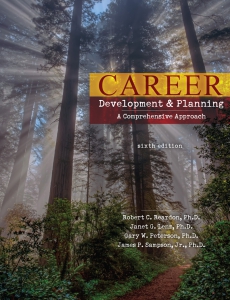by Robert C. Reardon, Janet G. Lenz, Gary W. Peterson, & James P. Sampson, Jr.

The sixth edition of Career Development and Planning was authored in 2019 by notable career researchers, Drs. Robert Reardon, Janet Lenz, Gary Peterson, and James Sampson. This book describes the processes behind theory-based career decision-making strategies and is written for a college-level audience as a guide for clients and students when formulating and implementing career decisions. In this review, an overview of the content included in the text and a description of the strengths and limitations will be provided for prospective readers to consider.
The text is organized into three sections of five chapters, each section covering a different aspect of career decision-making and planning. The first section describes the components of cognitive information processing (CIP) theory, including metacognitions, decision-making, self-knowledge, and options knowledge. Strategies for addressing each CIP theory component are provided. Some strategies are based within the theory such as the CASVE cycle for decision-making or the exploration of positive and negative self-talk to address meta-cognitions. Other strategies incorporate key tenets from other theories, including Holland’s RIASEC hexagon for self-knowledge clarification. Section two focuses on the sociological aspects of career decision-making, including organizational culture, work and family roles, the implementation of technology, and the different ways in which people conduct their work (e.g., job sharing, flex time, telecommuting). The final section of the text discusses strategies for launching a successful career search campaign, including resumé writing, networking, and salary and benefit negotiation. Tips for a successful college-to-employment transition are also included. Updated online resources for many of the topics covered in the text can be found throughout the chapters. Additionally, activities and worksheets related to the content can be found in the appendices of the text. Instructors can request the Instructor’s Manual as a text companion, but this resource was not available to this reviewer.
The organization of the information is an aspect that improves the reader’s experience. The semi-chronological structure provides an opportunity for readers to return to the text for guidance at any point in their career path. A primary strength of this text can be found in the appendices, which provide activities that enhance the learning experience by presenting an opportunity for personal reflection on text concepts. Additionally, resources are provided for readers who wish to learn more about the more specific topics covered in each chapter. Visual aids are included to assist readers in understanding abstract concepts and illustrate theories that may be otherwise difficult to comprehend.
By providing basic information on CIP theory, readers can reflect on these concepts as more information is presented while moving toward a career path. The detailed discussion of CIP theory included within the first section is unique to this book. Whereas most texts focus on the information provided in the second and third sections of this text, the inclusion of the theory is an effective way to assist students and clients with the basic skills needed for making major decisions.
Despite providing crucial information regarding career concerns, clients and students may find the text dense and difficult to navigate on their own. Because of this, career course instructors, counselors, and career professionals may find it beneficial to guide clients and students through the content and assist with connecting the information provided to personal experiences and goals. As previously discussed, the text provides activities that personalize these concepts; however, because these activities are located in the appendices, clients may have difficulty connecting the appropriate appendix item to the relevant topic. Future editions of this book may benefit from including more activities and making more obvious connections between topics and appropriate activities in relevant chapters.
Overall, Career Development and Planning is a worthy edition to any career course or career practitioner’s professional toolbelt, specifically for the resources, activities, and worksheets provided throughout the text. Additionally, the inclusion of CIP theory as the framework for the additional information provided sets this text apart from other career course texts and enables readers to use this framework while thinking through not only current career decisions, but other major decisions made throughout the life span. However, this book is meant to be a guide rather than a self-help solution to all career concerns. Career professionals will find this text to be a useful resource for clients and students with concerns ranging from deciding on the right career trajectory to preparing for their first job.
Reardon, R. C., Lenz, J. G., Peterson, G. W., & Sampson, J. P. (2019). Career development and planning: A comprehensive approach (6th ed.). Kendall Hunt Publishing.
Reviewed by: Jessica N. Schultz, University of Southern Mississippi
The Professional Counselor
